When looking for topics to write about, I’ve discovered that people sometimes search for what the notes on a ukulele are.
Most people are probably looking for the standard tuning notes, so let’s address this first (then we can get into other details):
What are the Tuning Notes on a Ukulele?
The standard tuning notes on soprano, concert, and tenor ukuleles are G4, C4, E4, and A4, with the C being middle C and the G, E, and A notes being those notes just above middle C.
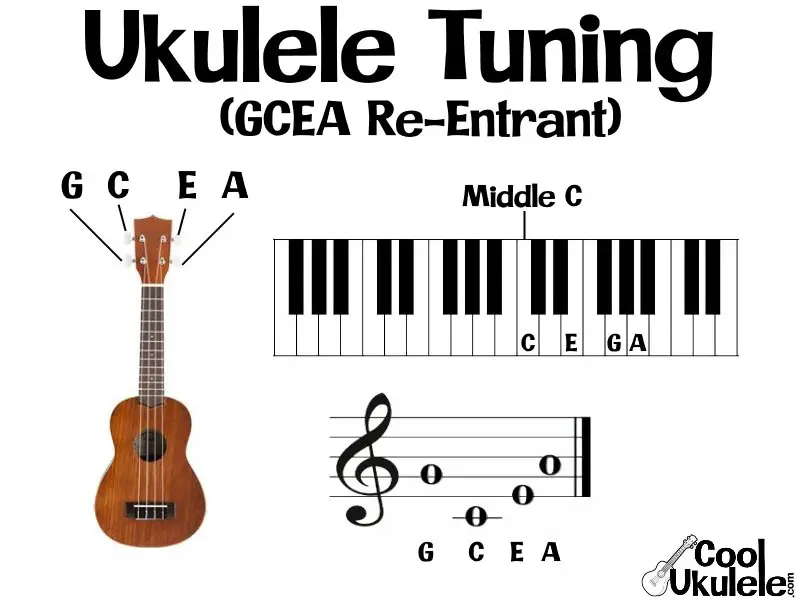
Now, this is actually a somewhat ambiguous question, as the “notes” on a ukulele could refer to either
A: the tuning notes, which are the pitches used when tuning the strings of the ukulele, or
B: the fret-board notes, which are pitches played when a string is held down at a particular fret on the instrument.
Let’s bring clarity to this ambiguity and cover both topics separately.
More on Tuning Notes
The tuning notes of the ukulele are the standard pitches which the ukulele’s strings are tuned to (i.e. tightened until they produce the desired sound frequency when plucked or strummed).
The tuning notes used depend mostly on the ukulele’s size, as the baritone uke traditionally uses a different tuning system from the other ukulele sizes.
Other exceptional factors can also influence the ukulele tuning notes alternative tuning systems or ukuleles with greater than 4 strings.
What are the Standard Tuning Notes on a Soprano, Concert, and Tenor Ukulele?
The standard tuning notes on soprano, concert, and tenor ukuleles are GCEA, with the C being middle C and the G, E, and A notes being those notes just above middle C.
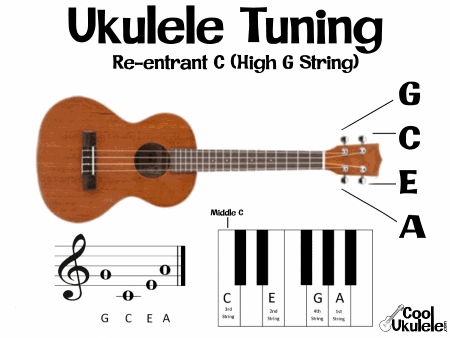
For more info on tuning these uke sizes, head over to the specific articles on soprano, concert, and tenor tuning.
What are the Standard Tuning Notes on a Baritone Ukulele?
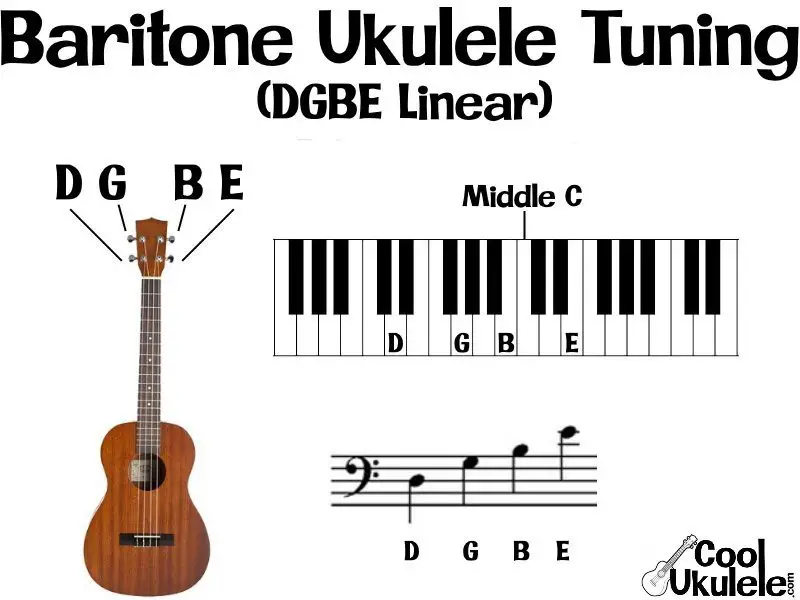
The standard tuning notes on a baritone ukulele are D, G, B, and E. With the D, G, and B being those below middle C, and the E being those above middle C.

What are the Tuning Notes on a Bass Ukulele?
The bass ukulele’s tuning notes are E1, A1, D2, and G2.
Much lower than even the Baritone uke.
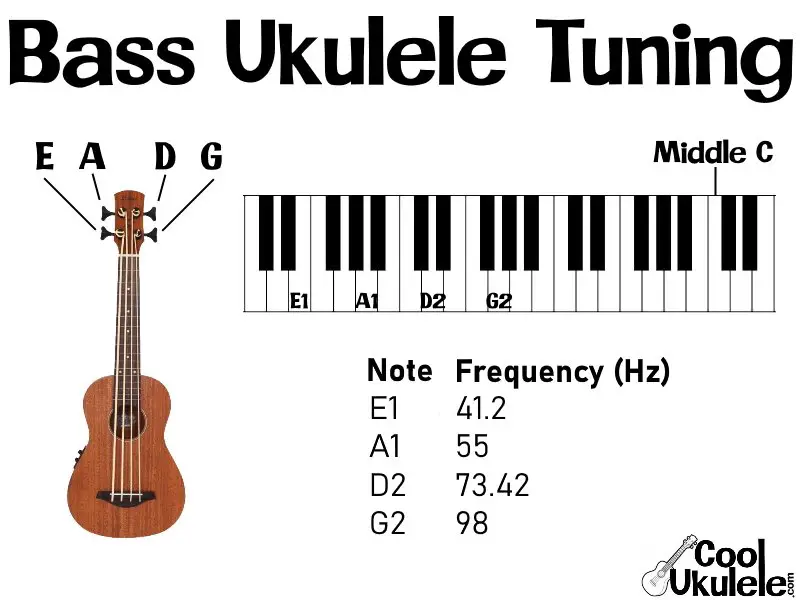
For more in-depth information, check out the bass ukulele tuning article.
What about Alternative Ukulele Tuning Notes?
Low G Tuning
One alternative tuning system used often is Low G tuning. The notes of this are the same as the standard tuning for soprano, except the G note is one octave lower, or the G below middle C instead of above it.
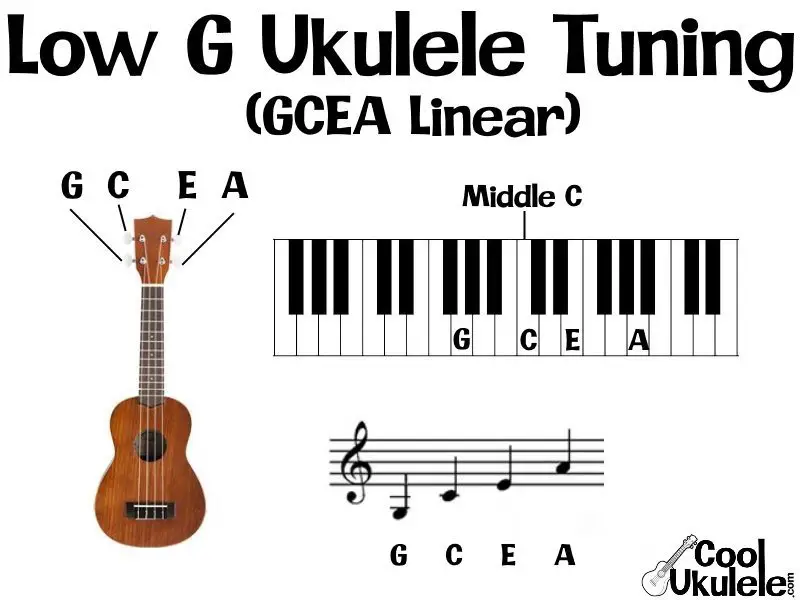
For a comparison of Low-G and High-G Ukulele tuning, check out the Low G vs. High G Ukulele Tuning article.

Tuning Notes for Ukuleles with More than 4 Strings
Tuning Notes on 6-string Ukuleles
Here’s a diagram of the tuning notes for a six string uke. Notice that one of the A strings can be either low or high.
With six and eight-string ukes, the tuning setups are much less standardized than their 4 string counterparts. The exact setup can vary from maker to maker and player to player.
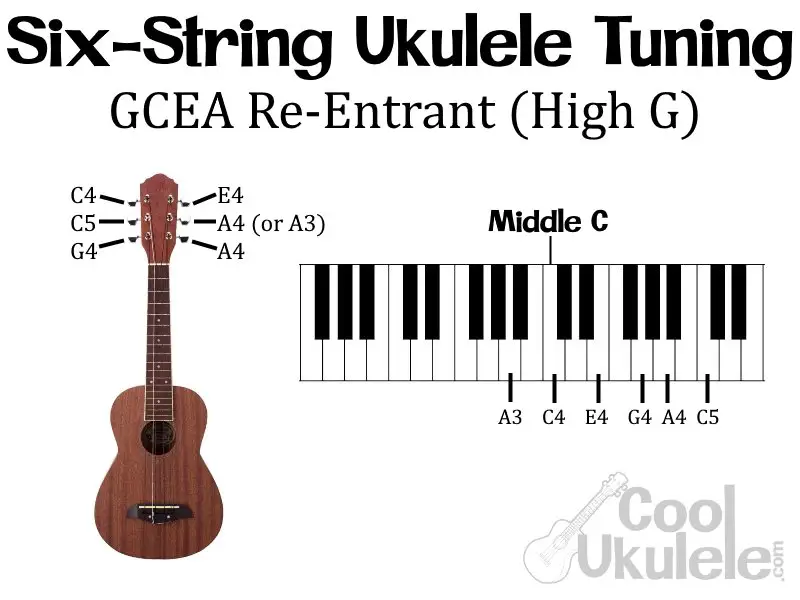
Tuning Notes on 8-string Ukuleles
And here’s the same for an 8 String ukulele.
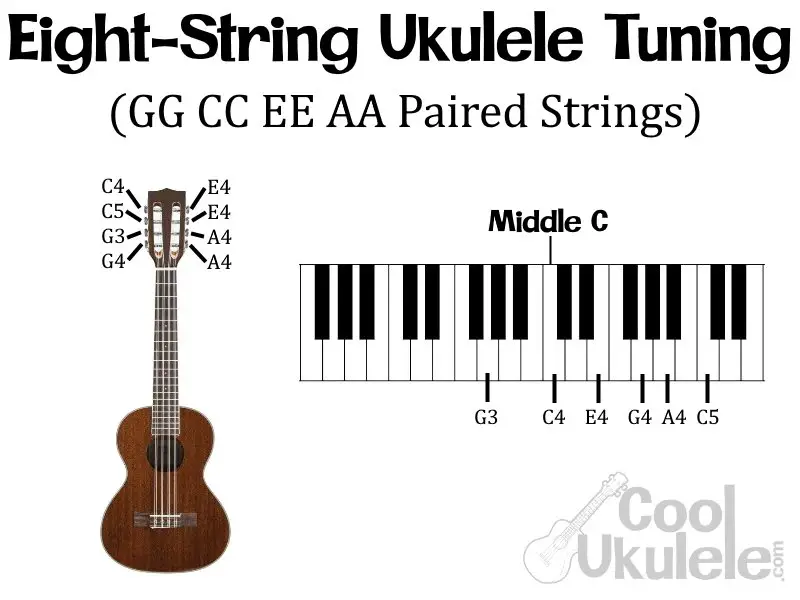
What are the Fret-board Notes of the Ukulele?
The fret-board is the part of the ukulele’s neck which has rows of metal frets along it. The strings are then held down at these frets to decrease the vibrating length of the string, thus altering its pitch.
The notes of the Ukulele fret-board depend on the tuning system used, however each fret raises the note by one half-step.
What are the Standard Fret-board Notes on a Soprano, Concert, and Tenor Ukulele?
As the standard tuning notes on soprano, concert, and tenor ukes are G, C, E, and A, the fret-board notes are a half-step higher pitched from those notes for each fret:
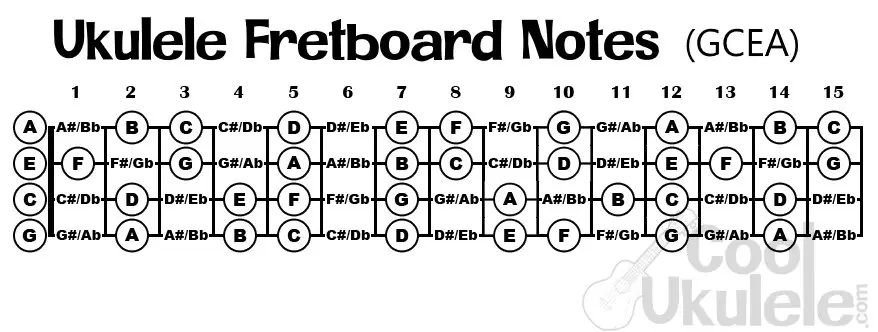
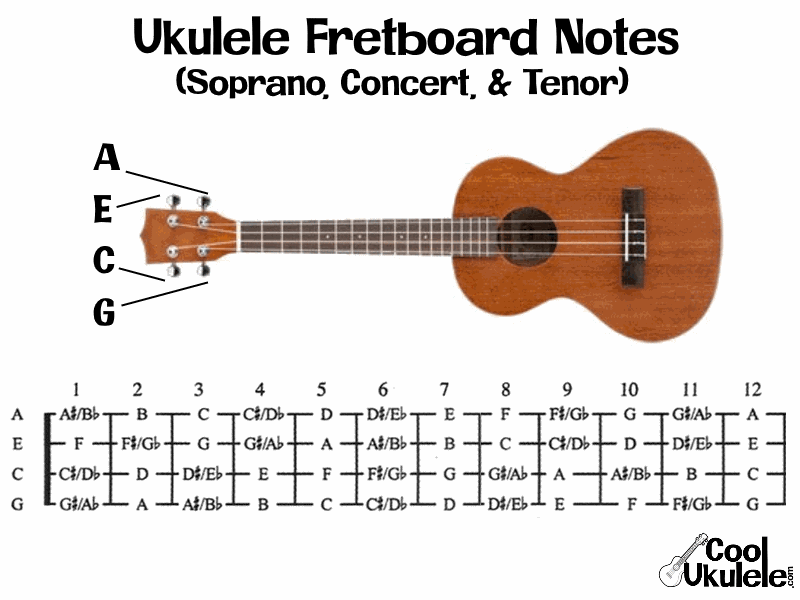
What are the Standard Fret-board Notes on a Baritone Ukulele?
The Baritone Ukulele traditional uses D, G, B, and E for its tuning set-up. This means the fret-board notes will be one half-step higher than these notes for each fret up the neck of the uke, as shown below:
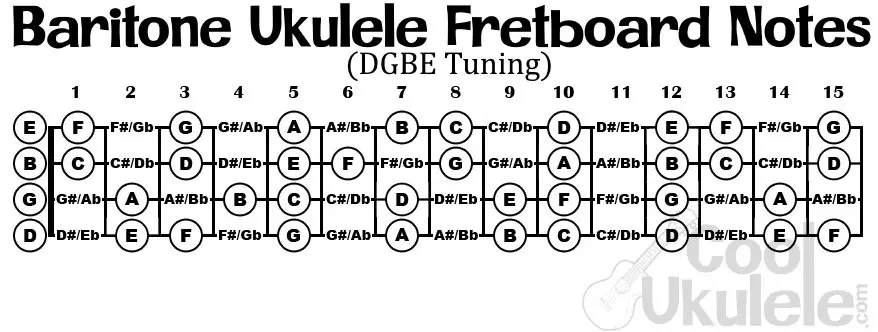
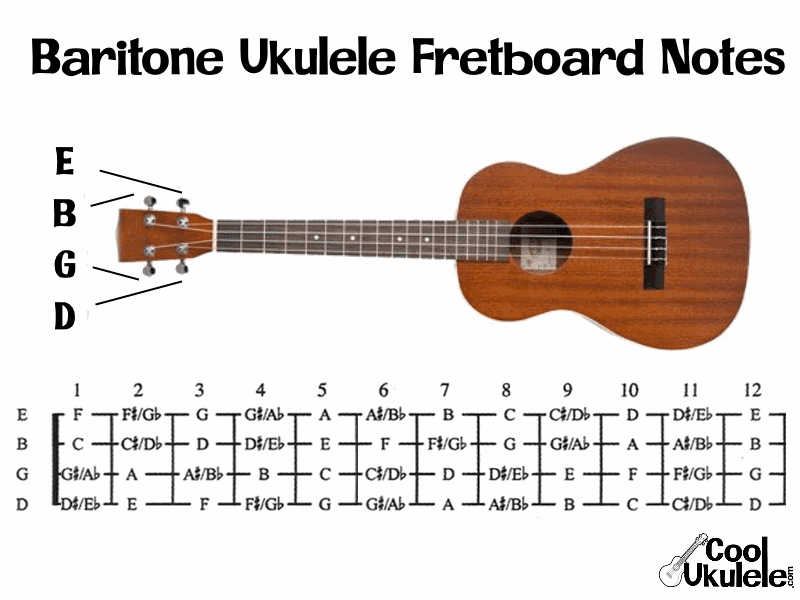
What are the Fretboard Notes on The Bass Ukulele?
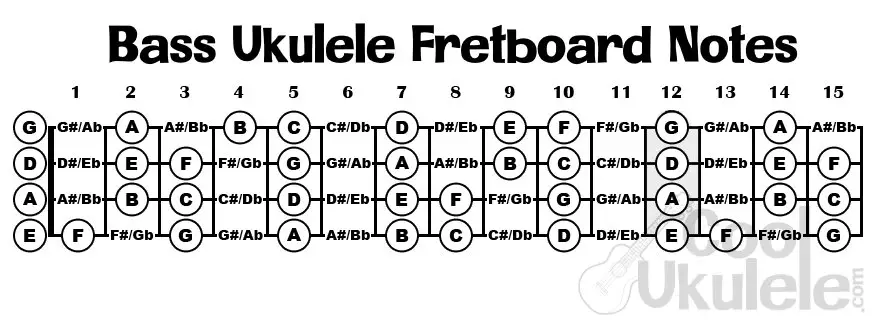
What about Ukulele Fret-board Notes for Alternative Tuning systems?
Low G Fretboard Notes
Here are the fretboard notes for a ukulele tuned to GCEA low G tuning.
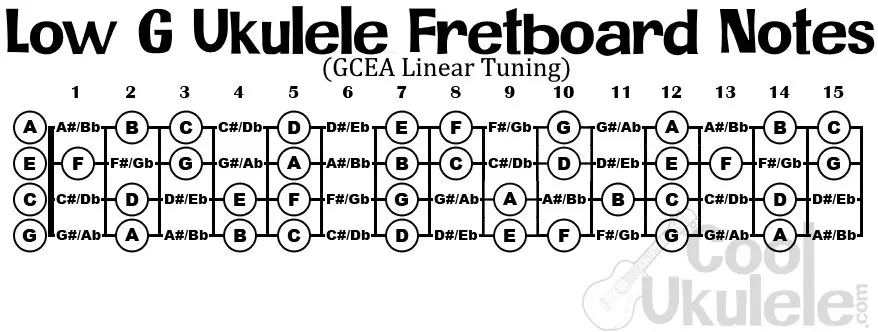
Techniques for Learning the Ukulele Fretboard
The four strings on a ukulele are tuned like the four highest sounding strings on a guitar, only 5 steps, or a fourth interval higher.
If you know how to play guitar chords, ukulele chords will be very easy.

The more notes on the fretboard you can memorize, the better it is for your playing.
Whenever you play a chord, you should practice identifying the root visually on the fretboard and by singing it.
This will help you connect what you hear with what you feel underneath your fingers.
An excellent way to learn the notes on the fretboard is to play major scales on each string and call out each note.
Start with a C scale on the A string and follow the formula for a major scale W-W-H-W-W-W-H. This translates to the notes C-D-E-F-G-A-B-C. Practice this two ways:
- Use a single finger, like your pointer or middle finger, to play all the notes. This requires you to slide up and down the fretboard.
- Use whichever fingers feel comfortable.
Start on a new note on the other strings and do the same thing. Sing the letter name of each note as you play it, and focus your ear on hearing how one note changes to the next. If you know how to sing using solfege, sing the solfege of each note as you play, i.e. Do-Re-Mi-Fa-So-La-Ti-Do. Try to hear the difference between whole steps and half steps in the scale. Half-steps are easier to hear.
- What is the sound of Mi going up to Fa?
- What is the sound of Ti going up to Do?
- What is the sound of Re going down to Do?
Recognizing how one note moves to the next is essential to being able to play by ear.
Another exercise is to choose a note and find the same note on all the other strings. For instance, on the G string, play an A (2nd fret). Then find the As on the rest of the strings. Move between them with a smooth, fluid motion.
Ukulele Fretboard Notes on The Piano and Music Staff
Now that we’ve looked at the different fretboard note layouts for the different ukulele tuning setups, let’s translate those notes onto the music staff and piano, in case someone is looking to learn to read ukulele music from traditional music notation or translate some music from piano to ukulele (or vice versa).
Here are the notes of a high-G GCEA tuned Ukulele translated to the piano keyboard and music staff.
The notes highlighted in dark gray are those notes in the octave starting on middle C.
The notes highlighted in a lighter gray are those notes in the octave starting on the C above middle C
The last C note is not highlighted because it starts a new octave.
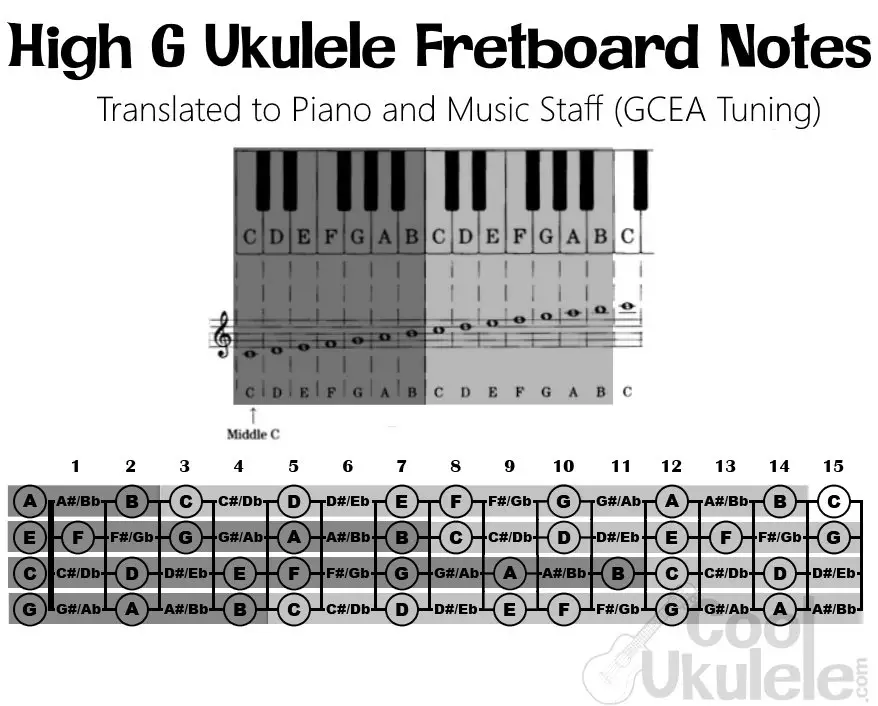
Hopefully this image is understandable.
Frequently Asked Questions
- What are the four standard tuning notes for a ukulele’s strings?
- The standard tuning notes for a ukulele, from top to bottom, are G, C, E, and A.
- How many frets does a typical ukulele have?
- A standard ukulele typically has 12 to 15 frets, though some may have more.
- What is the open string note on the first (A) string of a ukulele?
- The open A string on a ukulele is tuned to the note A.
- What is the open string note on the second (E) string of a ukulele?
- The open E string on a ukulele is tuned to the note E.
- What is the open string note on the third (C) string of a ukulele?
- The open C string on a ukulele is tuned to the note C.
- What is the open string note on the fourth (G) string of a ukulele?
- The open G string on a ukulele is tuned to the note G.
- What is the purpose of learning the notes on the ukulele fretboard?
- Learning the notes on the fretboard helps you understand music theory, play melodies, and improvise more effectively.
- How can I start learning the notes on the ukulele fretboard?
- Begin by memorizing the open string notes (G, C, E, A) and then work your way up the fretboard.
- What is the relationship between the 12th fret and the open strings on a ukulele?
- The notes on the 12th fret are the same as the open string notes but one octave higher.
- What are the natural notes on the ukulele (i.e., notes without sharps or flats)?
- The natural notes on the ukulele are A, B, C, D, E, F, and G.
- What is the order of the natural notes on the ukulele fretboard?
- The order of the natural notes on the ukulele fretboard is A, B, C, D, E, F, G, and then it repeats.
- How can I use mnemonics to remember the notes on the ukulele fretboard?
- Create memorable phrases or sentences to associate with each string. For example, “Good Cats Eat Always” can help you remember the open string notes.
- What is the significance of knowing the notes on the 3rd, 5th, 7th, and 9th frets of a ukulele?
- These frets can serve as reference points for finding notes and building chords and scales.
- What are the sharps and flats between the natural notes on the ukulele fretboard?
- The sharps (#) and flats (♭) are the notes that fall between the natural notes. For example, A#/B♭ falls between A and B.
- How can I practice identifying notes on the ukulele fretboard?
- Use flashcards, apps, or online resources designed to help you quiz yourself on note recognition.
- What are the octave notes on the ukulele?
- Octave notes are the same note as an open string but played at a higher fret. For example, the 2nd fret of the A string is an octave higher than the open A string.
- How can learning the notes on the ukulele help me with chord progressions?
- Knowing the notes helps you understand chord construction and enables you to create chord progressions more easily.
- What is the benefit of learning the notes on the ukulele for playing scales?
- Knowing the notes allows you to play scales in various positions on the fretboard, which is essential for soloing and improvisation.
- How can I find specific notes on the ukulele fretboard quickly?
- Use reference points like the open strings and octave patterns to locate notes efficiently.
- What is the relationship between the ukulele and the piano in terms of note layout?
- The ukulele’s notes are laid out similarly to a section of the piano keyboard, making it easier to transfer knowledge between the two instruments.
- How can I practice finding notes on the ukulele in different positions and octaves?
- Play scales, melodies, or simple songs in different positions on the fretboard to reinforce your note recognition skills.
- What is the importance of knowing the notes on the ukulele when reading sheet music or tablature?
- Understanding the notes helps you translate written music into actual finger positions on the ukulele.
- Can I use mnemonic devices to remember the order of the natural notes on the ukulele fretboard?
- Yes, mnemonics can be a helpful memory aid. For instance, “All Cows Eat Grass” represents the notes A, C, E, and G.
- What is the difference between the first and second string (A and E) notes on a high-G and low-G ukulele?
- On a high-G ukulele, the first string is A and the second string is E. On a low-G ukulele, it’s the opposite, with the first string being E and the second string A.
- Are there any useful apps or online tools for practicing note recognition on the ukulele?
- Yes, there are several apps and websites that offer interactive note recognition exercises for ukulele players.
- How can I practice naming the notes on the ukulele while playing familiar songs?
- Take songs you already know and try to identify and name the notes as you play them.
- What are some common positions for locating specific notes on the ukulele?
- Common positions include the 5th fret (A), 7th fret (B), 3rd fret (C), 2nd fret (D), and 12th fret (octave).
- How can I apply my knowledge of the ukulele’s notes to songwriting or creating melodies?
- Knowing the notes allows you to intentionally select chords and melodies that fit well together, enhancing your songwriting skills.
- What is the role of muscle memory in learning the notes on the ukulele fretboard?
- Over time, your fingers develop muscle memory for finding notes, making playing easier and more intuitive.
- What are some fun and creative exercises to reinforce note knowledge on the ukulele?
- Create your own note-based melodies, compose songs, or try transposing songs to different keys to challenge yourself and improve your note recognition skills.
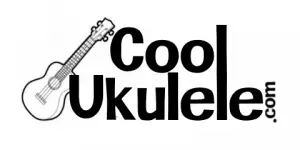
Hi there! Could please design the ukulele music notes on the grand staff to match the notes on the fretboard,
I’ve added an image/section to the article showing the fretboard notes on the staff (and also piano).
Currently, it’s only in GCEA re-entrant tuning, but I’ll add others as I make them.
Thanks for the suggestion!
hey! I don’t know if this should be obvious or not, but I seem to be having a hard time fully understanding the notes on the fretboard and how a capo changes the key, and how that affects the notes on the fretboard. thank you!!
Hi, sorry for the late reply.
I don’t check my comments often enough and I get a lot of spam so it takes a while to sift through.
Using a capo doesn’t actually change any of the notes on the fretboard, it just shifts up the open strings to the fret that the capo is on.
This could be considered changing the key (maybe more accurately the “open key”) of the instrument, as you mentioned, because playing the open chord shapes from the capo fret would produce the chord as many half-steps higher as the capo is from the open strings (fret 0).
For example, if you put the capo across the 2nd fret, and you play the shape of what is usually an open C major chord (0-0-0-3), except from the capo fret instead of the open strings, this new chord would be a D major (2 half steps higher than C major).
It would be the same as playing the chord 2-2-2-5 (D major), except you don’t have to hold down all the 2’s.
Another example. if you put the capo across the 1st fret and played what is usually an open A minor chord (2-0-0-0), except from the capo fret instead of the open strings, the new chord would be an A#(or Bb) minor.
This would be the same as playing the chord 3-1-1-1 (A#/Bb minor), except you don’t have to hold down the 1’s.
A capo is generally used so that you can play these open chords, which are generally easier (fewer fingers holding down fewer strings), in other keys.
Maybe another way to think of it is that the capo is just another hand/finger holding down the strings across its fret?
At some point, I’ll have to add a section to this article (or make another) with a more detailed explanation, pictures, etc.
Hopefully, that’s helpful. This stuff can definitely be confusing.
And thanks for the comment!